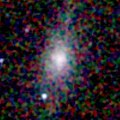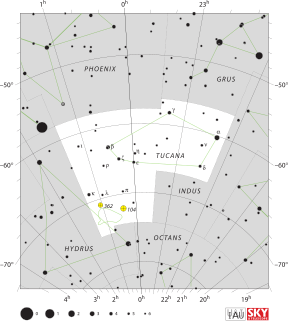
Tucana is a constellation of stars in the southern sky, named after the toucan, a South American bird. It is one of twelve constellations conceived in the late sixteenth century by Petrus Plancius from the observations of Pieter Dirkszoon Keyser and Frederick de Houtman. Tucana first appeared on a 35-centimetre-diameter (14 in) celestial globe published in 1598 in Amsterdam by Plancius and Jodocus Hondius and was depicted in Johann Bayer's star atlas Uranometria of 1603. French explorer and astronomer Nicolas Louis de Lacaille gave its stars Bayer designations in 1756. The constellations Tucana, Grus, Phoenix and Pavo are collectively known as the "Southern Birds".

NGC 1232 is an intermediate spiral galaxy about 60 million light-years away in the constellation Eridanus. It was discovered by German-British astronomer William Herschel on 20 October 1784.

NGC 248 is an emission nebula in the constellation Tucana. It is in the Small Magellanic Cloud. It was discovered in 1834 by the astronomer John Frederick William Herschel. NGC 248 is about 60 light-years long and 20 light-years wide

NGC 78 is a pair of galaxies in the constellation Pisces. NGC 78A, which is the more southern galaxy, is a barred spiral galaxy. NGC 78B, which is the more northern galaxy, is an elliptical galaxy. Although the designations NGC 78A and 78B are used today, the designation NGC 78 was formerly used mainly for the northern galaxy.

NGC 299 is an open cluster of stars in the main body of the Small Magellanic Cloud – a nearby dwarf galaxy. It is located in the southern constellation of Tucana, just under 200,000 light years distant from the Sun. The cluster was discovered on August 12, 1834 by English astronomer John Herschel.

NGC 361 is an open cluster in the Small Magellanic Cloud. It is located in the constellation Tucana. It was discovered on September 6, 1826 by James Dunlop. It was described by Dreyer as "very very faint, pretty large, very little extended, very gradually brighter middle." At an aperture of 31.0 arcseconds, its apparent V-band magnitude is 12.24, but at this wavelength, it has 0.40 magnitudes of interstellar extinction.

NGC 376 is a young open cluster of stars in the southern constellation of Tucana. It was discovered on September 2, 1826 by Scottish astronomer James Dunlop. Dreyer, a Danish/British astronomer, described it as a "globular cluster, bright, small, round." It is irregular in form, with a central spike.

NGC 411 is an globular cluster located approximately 55,000 pc (180,000 ly) in the constellation Tucana. It was discovered in 1826 by James Dunlop. It was described by Dreyer as "extremely faint, pretty large, round, gradually very little brighter middle." At a distance of about 180,000 light years (55,000 parsecs), it is located within the Small Magellanic Cloud. It has a mass of about 3.0×104 M☉, and a luminosity of about 8.0×104 L☉.

NGC 419 is an globular cluster located approximately 57,000 pc (190,000 ly) in the constellation Tucana. It was discovered on September 2, 1826 by James Dunlop. It was described by Dreyer as "pretty large, pretty bright, round, gradually brighter middle." At a distance of about 186,000 light years, it is located within the Small Magellanic Cloud. At an aperture of 50 arcseconds, its apparent V-band magnitude is 10.30, but at this wavelength, it has 0.15 magnitudes of interstellar extinction.
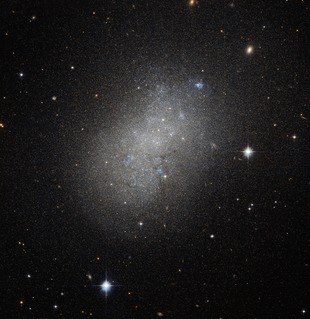
NGC 5264, also known as DDO 242, is an irregular galaxy in the constellation Hydra. It is part of the M83 subgroup of the Centaurus A/M83 Group, located some 15 million light years away. The galaxy was discovered on 30 March 1835 by John Herschel, and it was described as "very faint, pretty large, round, very little brighter middle" by John Louis Emil Dreyer, the compiler of the New General Catalogue.
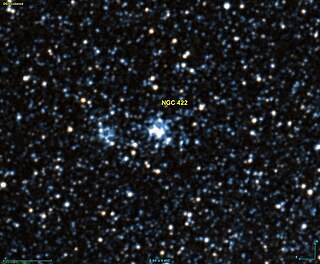
NGC 422 is an open cluster located in the constellation Tucana. It was discovered on September 21, 1835 by John Herschel. It was described by Dreyer as "very faint .", with Nubecular Minor being the Small Magellanic Cloud. It was also described by DeLisle Stewart as "only 3 extremely faint stars, close together, not a nebula."

NGC 458 is an open cluster located in the constellation Tucana. It was discovered on September 6, 1826, by James Dunlop. It was also observed by John Herschel and DeLisle Stewart. It was described by Dreyer as "pretty faint, large, round, very gradually brighter middle." It was also noted in the second Index Catalogue that it was "probably a cluster, extremely small, close, no nebulosity seen by D.S. ." At an aperture of 31 arcseconds, its apparent V-band magnitude is 11.73, but at this wavelength, it has 0.12 magnitudes of interstellar extinction.

NGC 466 is a lenticular galaxy located about 227 million Light-years away from Earth in the constellation Tucana. NGC 466 was discovered by astronomer John Herschel on October 3, 1836.
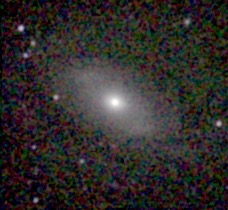
NGC 7098 is a doubled barred spiral galaxy located about 95 million light-years away from Earth in the constellation of Octans. NGC 7098 has an estimated diameter of 152,400 light-years. NGC 7098 was discovered by astronomer John Herschel on September 22, 1835.
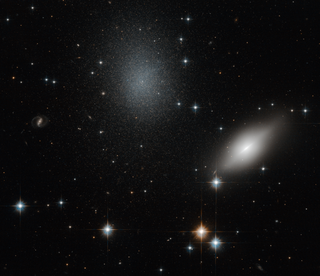
NGC 5011 is an elliptical galaxy in the constellation of Centaurus. It was discovered on 3 June 1834 by John Herschel. It was described as "pretty bright, considerably small, round, among 4 stars" by John Louis Emil Dreyer, the compiler of the New General Catalogue.

NGC 7069 is a Lenticular galaxy located about 400 million light-years away in the constellation of Aquarius. NGC 7069 is also classified as a LINER galaxy. NGC 7069 was discovered by astronomer Albert Marth on October 12, 1863.

NGC 484 is an elliptical galaxy in the constellation Tucana. It is located approximately 218 million light-years from Earth and was discovered in on October 28, 1834 by astronomer John Herschel.

NGC 519, also occasionally referred to as PGC 5182 is an elliptical galaxy located approximately 242 million light-years from the Solar System in the constellation Cetus. It was discovered on 20 November 1886 by astronomer Lewis Swift.

NGC 521, also occasionally referred to as PGC 5190 or UGC 962, is a spiral galaxy located approximately 224 million light-years from the Solar System in the constellation Cetus. It was discovered on 8 October 1785 by astronomer William Herschel.

NGC 525, also occasionally referred to as PGC 5232 or UGC 972 is a lenticular galaxy located approximately 95.6 million light-years from the Solar System in the constellation Pisces. It was discovered on 25 September 1862 by astronomer Heinrich d'Arrest.

